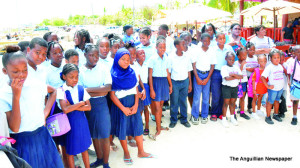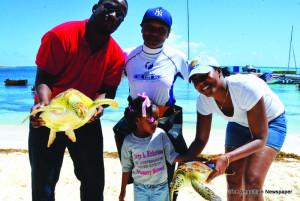
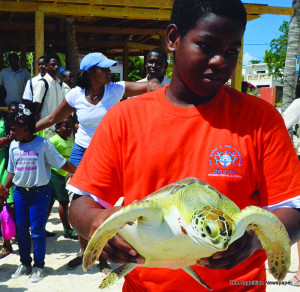
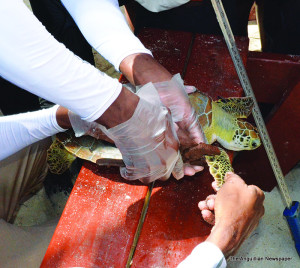
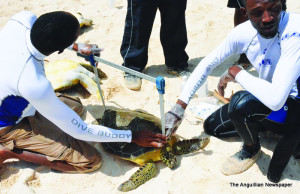 Wednesday, May 27, was an exciting day for large numbers of children from various public and private schools in Anguilla. That was when they witnessed, for the first time, the measuring and tagging of eighteen greenback turtles of varying sizes at Island Harbour Beach. Following that process, the released turtles sped off beneath the inshore waters to the deeper areas.
Wednesday, May 27, was an exciting day for large numbers of children from various public and private schools in Anguilla. That was when they witnessed, for the first time, the measuring and tagging of eighteen greenback turtles of varying sizes at Island Harbour Beach. Following that process, the released turtles sped off beneath the inshore waters to the deeper areas.
The turtles were caught in a net set by personnel from the Marine Resources and Fisheries Department, assisted by a number of volunteers and supervised by the Director, Marine Biologist, Ms. Kaffi Gumbs as well as Carlos Sasso.
“We are doing tagging of the greenback turtles,… Once a year we set nets in Island Harbour Bay where there is a nice thick sea grass bed where they feed,” Ms. Gumbs told The Anguillian. “Once we catch them we bring them on land to do the tagging. We insert a tracking device in the neck of the turtle and also use another tag pinned onto to the slipper of the turtle. In that way, if we caught the turtle again, or if is captured somewhere else in the region, Anguilla can be notified as the tags correspond with and are identified with a certain country. A few years back, one of our turtles was found in South America.”
Ms. Gumbs continued: “The tagging is important as it gives us an idea where the turtles are migrating to; where they are feeding; their growth rates; and information about their population. Seven schools were represented as we wanted to teach the children a little about turtles. We also invited the Hotel and Tourism Association, environmental groups, volunteers from the Anguilla National Trust and others as part of a public sensitisation.”
Ms. Gumbs was told that, according to reports, there was a notable large proliferation of turtles in Anguillian waters, and persons were wondering whether there was time to lift the ban on catching some of them.
She replied as follows: “We get questions all the time on lifting the ban on turtles but that is beyond us. Anguilla, being a British Overseas Territory, there would be a lot of red tape to lift the ban. It is not something that we really want to encourage right now as we are still collecting certain data to see how the turtle population is doing. People believe that there are a lot of turtles because everywhere they go they are seeing them. But the thing about it is that the growth rate is so slow that even if you are seeing a lot, and you lift the ban, it is very easy to wipe them out. Turtles would lay hundreds of eggs but only one baby turtle would survive. That’s why we have to be careful about lifting the ban and allowing people to catch such fragile species like the turtle.”
Ms. Gumbs explained that the turtles in Anguilla’s waters are migratory species, travelling long distances, although they feed and nest here. “We have greenback, hawksbill and leatherback turtles in our waters,” she added.

